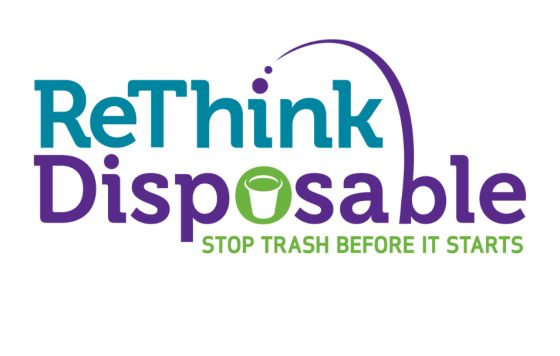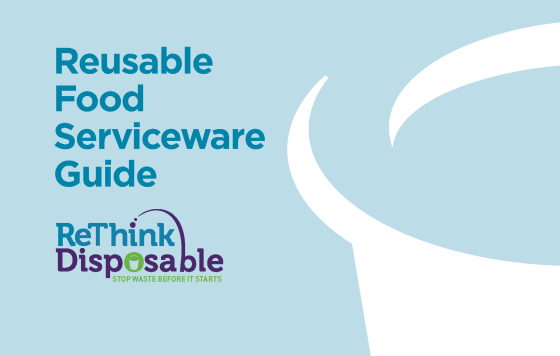This page was originally published in 2012. For our current work on reducing single-use waste from working directly with businesses to switch to reusable items, working to pass plastic bag bans, and more, please visit our ReThink Disposable campaign and Sustainability priority sections.
The United States represents 5% of the world’s population, yet consumes about a quarter of the planet’s resources. Much of this is a result of our “throw away” lifestyle, whereby many products are used once and then thrown away forever. This started in the 1950s when the plastics and chemical industries sold the American public on the convenience of single-use disposable items. Decades later, the throwaway lifestyle has led to packaging waste (mostly plastic) making up 30% of American household trash. In 2011, the average American produced 4.4 pounds of household garbage per day, twice as much as in 1960. This linear approach to resource consumption has big impacts for our communities, the marine environment and even how our taxpayer dollars are spent.
Marine Debris
Land-based sources contribute the vast majority of marine debris in the world’s oceans – 80% comes from trash on urban streets that gets washed into local and coastal waters when it rains. Key components of land-based sources of marine litter include litter, trash, debris from construction, ports and marinas, commercial and industrial facilities, and trash blown out of garbage containers, trucks, and landfills. Plastics comprise 60-80% of the marine debris in the ocean. In addition, plastics are widely dispersed in the ocean water column, on the seafloor, and in every ocean on the planet. In the famous Pacific garbage patch, plastic outweighs plankton 46 to 1. This number increased almost tenfold in the last decade and is expected to do so again in the coming decade.
Plastic debris injures and kills fish, seabirds and marine mammals. Marine plastic pollution has impacted at least 267 species worldwide, including 86% of all sea turtle species, 44% of all seabird species and 43% of all marine mammal species. The impacts include fatalities as a result of ingestion, starvation, suffocation, infection, drowning, and entanglement. Plastic debris adsorbs and transports pollutants, which can bioaccumulate up the food chain, polluting seafood.
Litter Control and Clean Up
Controlling and cleaning up litter is one way to address the problem of trash in the marine environment – and we certainly support this approach. The problem is that we can’t clean up all the trash that pollutes waterways, and cleanup doesn’t address the unsustainable consumption of resources involved in producing packaging and single use disposable goods. Furthermore, as the amount of disposable packaging and products continues to increase, controlling litter through public education and cleanup of streets and waterways requires significant and sustained funding that is rarely available. Enforcement of fines for littering is rarely a priority for law enforcement, especially in urban areas where crime takes precedent.
The plastics industry, through the leadership of the American Chemical Council (ACC), spends millions of dollars each year to convince policy makers and Californians that solutions to plastic pollution lie in anti-litter campaigns that attribute the responsibility for marine debris and plastic pollution on individual behavior. At the same time, California currently places the burden to control trash before it gets into water bodies on local jurisdictions. The EPA found that West Coast cities spend over $520 million per year to control trash and litter before it enters waterways. As this problem continues to grow, taxpayers will foot an increasingly large bill for controlling trash. For these reasons, we pursue strategies that stop litter at the source by minimizing single use disposable products.
Recycling is Only Part of the Solution
Many people forget that reduce and reuse come before recycling in the 3Rs of waste management (Reduce, Reuse, and Recycle). While recycling is certainly important, there is often too much focus on diverting single-use disposables from the landfill by recycling or composting instead of stopping this waste before it starts. These materials are resource intensive to produce, manufacture and recycle – overall packaging and single-use products represent an unsustainable use of precious resources (oil, trees, energy, water).
As reliance on single-use disposables has increased, recycling rates have not been able to keep up. In US, 2.4 million tons of plastic were recycled in 2010, which sounds great until you realize that that’s only 8% of the plastic generated. California typically has better recycling rates because of the CRV incentive, which resulted in 92% recycled of HDPE (shampoo, cleaning chemical bottles, etc.) and 68% of PET (soft drink and water bottles) in 2010. However, these types of plastic make up less than half of the total plastics generated and less than 10% of other plastics were recycled in California in 2010.

